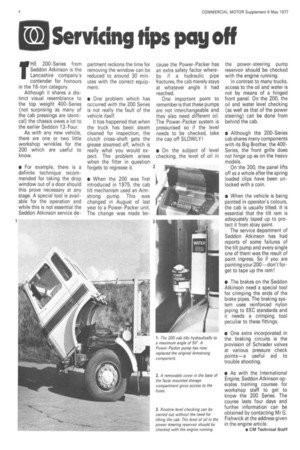Servicing tips pay off
Page 58

If you've noticed an error in this article please click here to report it so we can fix it.
THE 200-Series from Seddon Atkinson is the Lancashire company's contender for honours in the 16-ton category.
Although it shares a distinct visual resemblance to the top weight 400-Series (not surprising as many of the cab pressings are identical) the chassis owes a lot to the earlier Seddon 13-Four, As with any new vehicle, there are one or two little workshop wrinkles for the 200 which are useful to know.
• For example, there is a definite technique recom.mended for taking the drop window out of a door should this prove necessary at any stage. A special tool is available for the operation and while this is not essential the Seddon Atkinson service de
partment reckons the time for removing the window can be reduced to around 30 minutes with the correct equipment.
• One problem which has occurred with the 200 Series is not really the fault of the vehicle itself.
It has happened that when the truck has been steam cleaned for inspection, the clutch cross-shaft gets the grease steamed off, which is really what you would expect. The problem arises when the fitter in question forgets to regrease it.
• When the 200 was first introduced in 1975, the cab tilt mechanism used an Armstrong pump. This was changed in August of last year to a Power-Packer unit. The change was made be cause the Power-Packer has an extra safety factor whereby if a hydraulic pipe fractures, the cab merely stays at whatever angle it had reached.
One important point to remember is that these pumps are not interchangeable and they also need different oil. ,The Power-Packer system is pressurised so if the level needs to be checked, take the cap off SLOWLY!
• On the subject of level checking, the level of oil in the power-steering pump reservoir should be checked with the engine running.
In contrast to many trucks, access to the oil and water is not by means of a hinged front panel. On the 200, the oil and water level checking (as well as that of the power steering) can be done from behind the cab.
• Although the 200-Series cab shares many components with its Big Brother, the 400Series, the front grille does not hinge up as on the heavy models.
On the 200, the panel lifts off as a whole after the spring loaded clips have been unlocked with a coin.
• When the vehicle is being painted in operator's colours, the cab is usually tilted. It is essential that the tilt ram is adequately taped up to protect it from stray paint.
The service department of Seddon Atkinson has had reports of some failures of the tilt pump and every single one of them was the result of paint ingress. So if you are
painting your 200 don't forget to tape up the ram!
• The brakes on the Seddon Atkinson need a special tool for crimping the ends of the brake pipes. The braking system uses reinforced nylon piping to EEC standards and it needs a crimping tool peculiar to these fittings.
• One extra incorporated in the braking circuits is the provision of Schrader valves at various pressure check points—a useful aid to trouble shooting.
• As with the International Engine, Seddon Atkinson operates training courses for workshop staff to get to know the 200 Series. The course lasts four days and further information can be obtained by contacting Mr G. Fishwick at the address given in the engine article.
























































































































